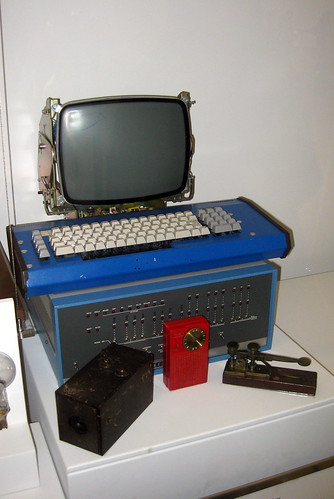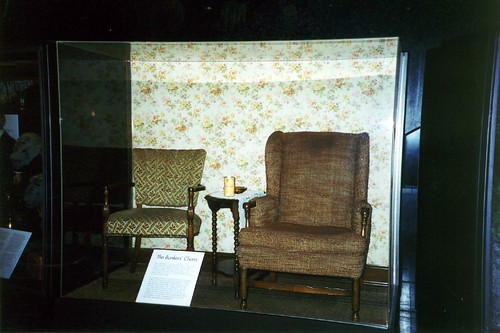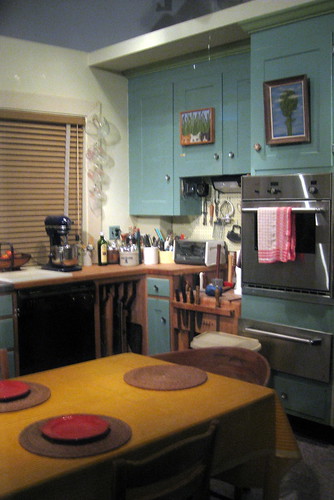A few nice Washington Nationals images I found:
Washington DC – National Museum of American History: Inventions

Image by wallyg
At the top is the Micro Instrumentation and Telemetry Systems Altair 8800, a personal computer with keyboard and monitor, dating from about 1975. The company sold only the basic processor kit. Owners addd keyboards, monitors and other accessories.
On the bottom left is a camera dating from the 1880’s. George Eastman revolutionized photography with the introduction of the Kodak. Owners mailed the camera to Eastman Company to have their pictures developed and printed, and the camera reloaded.
On the bottom center is a radio dating from 1954. American firms Texas Instruments and IDEA devleoped the Regency TR-1, the world’s first commercially available transistor radio. It helped popularize another recent invention–rock and roll music.
On the bottom right is a telegraph key, dating from around 1844. Samuel Morse and Alfred Vail likely used this transmitter at the 1844 official opening of their electric telegraph line. For the first time people could communicate almost instantly over long distances.
The National Museum of American History (NMAH), administered by the Smithsonian Institute, collects, preserves and displays American heritage in the areas of social, political, cultural, scientific and military history. The museum, which first opened in 1964 as the Museum of History and Technology, is located on the National Mall in one of the last structures designed by McKim, Mead & White. It was renamed in 1980, and closed for a 2-year, million renovation by Skidmore, Owings & Merrill LLP from 2006 to 2008.
The Smithsonian Institution, an educational and research institute and associated museum complex, administered and funded by the government of the United States and by funds from its endowment, contributions, and profits from its shops and its magazines, was established in 1846. Although concentrated in Washington DC, its collection of over 136 million items is spread through 19 museums, a zoo, and nine research centers from New York to Panama.
Washington DC – National Museum of American History: The Bunkers’ Chairs

Image by wallyg
The familiar chairs belonging to Archie and Edith Bunker, of the sitcom All in the Family, were originally purchased by the show’s set designer for at a local Goodwill thrift store. Produced by Norman Lear and based on the British series Til Death us Do Part, All in the Family aired on CBS from 1971-1979, when it was retooled as Archie Bunker’s Place where it lasted another 4 years. When Lear thought the show was ending after the eighth season, he donated the chairs chair to the Smithsonian through the efforts of Indiana Democratic Representative John Brademas. When Lear discovered the show was renewed for a ninth season, he had to spend thousands of dollars to create replicas for the set.
The Bunkers were said to live at 704 Hauser Street, a fictitious address that was supposed to be located in Astoria, but in actuality doesn’t exist. The exterior house used for the credits, however, is located in Glendale, at 89-70 Cooper Avenue.
The National Museum of American History, administered by the Smithsonian Institute, collects, preserves and displays American heritage in the areas of social, political, cultural, scientific and military history. The museum, which first opened in 1964 as the Museum of History and Technology, is located on the National Mall in one of the last structures designed by McKim, Mead & White. It was renamed in 1980, and closed for a 2-year renovation by Skidmore, Owings & Merrill LLP from 2006 to 2008.
The Smithsonian Institution, an educational and research institute and associated museum complex, administered and funded by the government of the United States and by funds from its endowment, contributions, and profits from its shops and its magazines, was established in 1846. Although concentrated in Washington DC, its collection of over 136 million items is spread through 19 museums, a zoo, and nine research centers from New York to Panama.
Washington DC – National Museum of American History: Bon Appétit! Julia Child’s Kitchen at the Smithsonian

Image by wallyg
When Julia Child moved back to her home state of California in 2001, she donated the kitchen from her Cambridge, Massachusetts, home to the Museum. Bon Appétit! Julia Child’s Kitchen at the Smithsonian, an ongoing exhibitio, features the actual kitchen, including the cabinets, appliances, cookbooks, kitchen table, and hundreds of utensils and gadgets. The exhibition gives visitors a peek into the working kitchen of one of the world’s best-known cooks, and explores how her influence as an author and host of several television series changed the way America cooks.
The National Museum of American History (NMAH), administered by the Smithsonian Institute, collects, preserves and displays American heritage in the areas of social, political, cultural, scientific and military history. The museum, which first opened in 1964 as the Museum of History and Technology, is located on the National Mall in one of the last structures designed by McKim, Mead & White. It was renamed in 1980, and closed for a 2-year, million renovation by Skidmore, Owings & Merrill LLP from 2006 to 2008.
The Smithsonian Institution, an educational and research institute and associated museum complex, administered and funded by the government of the United States and by funds from its endowment, contributions, and profits from its shops and its magazines, was established in 1846. Although concentrated in Washington DC, its collection of over 136 million items is spread through 19 museums, a zoo, and nine research centers from New York to Panama.
